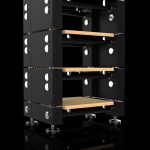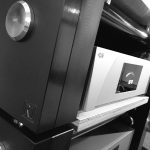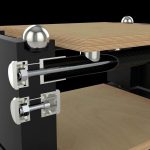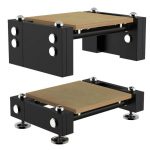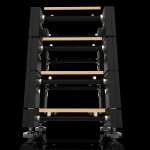Developed through extensive testing with the industries leading audio components, the R1 is the most advanced Hi-Fi rack ever developed. Design details across the R1, are indicative of the exceptional attention to detail and ‘total engineering’ approach to the products design. Each component working in harmony to create an energy management system that draws unwanted structural borne resonance away from sensitive audio components.
The striking monolithic R1 ‘vertical nodes’ are machined and finished in house, to a tolerance of 0.02mm. Each level in the R1 rack consists of two vertical nodes, which is assembled from six high mass blocks of polyoxymethylene (POM). The material has been selected for its hardness and machinability, much like aluminium, with the advantage that it is exceptionally well damped.
The R1 vertical nodes are cross-linked by elegant carbon fibre ‘Isobars’ which form the support for the marine ply shelves. 14mm steel bars, tied at the ends with precision machined sockets run through the centre of the Isobars, compressing them under tons of pressure along their length. This improves the energy transmission pathway along the carbon fibre tube, creating a pathway between the sensitive audio components and the nodes that draw unwanted energy, which would otherwise manifest as resonance in the audio components, away and into the nodes that absorbs and dissipates the energy.
Elegant examples of these highly optimised energy pathways can be seen across the R1 design.
At the interface between the carbon fibre Isobar and the marine plywood shelf, Wilson Benesch have designed fluted cups that are precision machined to create two points which meet with the carbon fibre.
Each R1 rack interfaces with the next by four huge 500g chrome steel spheres that locate kinematically with four sockets on the adjoining R1 rack. The interface creates an assured feel to the whole design; there is a palpable feeling of precision when placing each R1 rack onto the next. But the nodes are a functional design element, the nodes legislate that tons of pressure is focussed equally through the four nodes.
Modular in design, micro-adjustable in setup, the R1 is fitted with four spikes taken directly from the same shelf as the Cardinal loudspeaker. Four ball bearing tipped spikes kinematically located into four floor cups holding captive three ball bearings to create the final energy node.
The R1; Total engineering.

